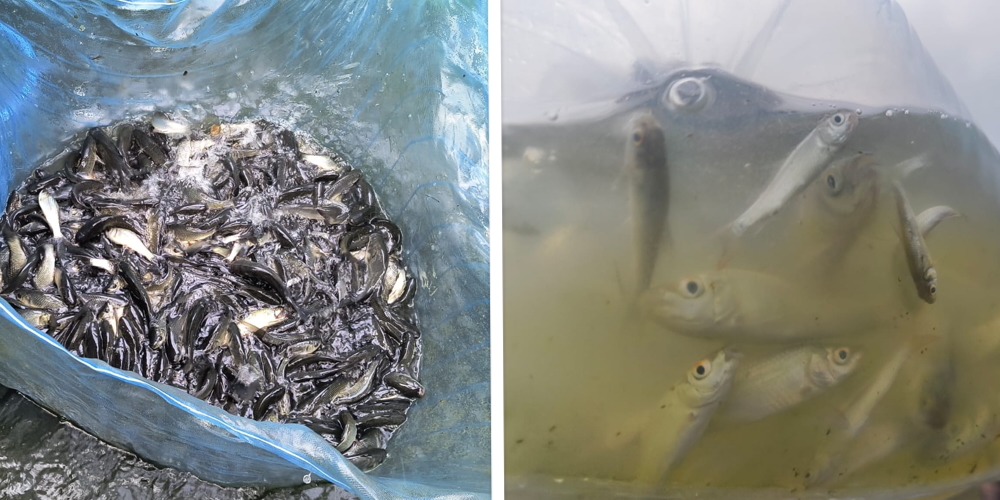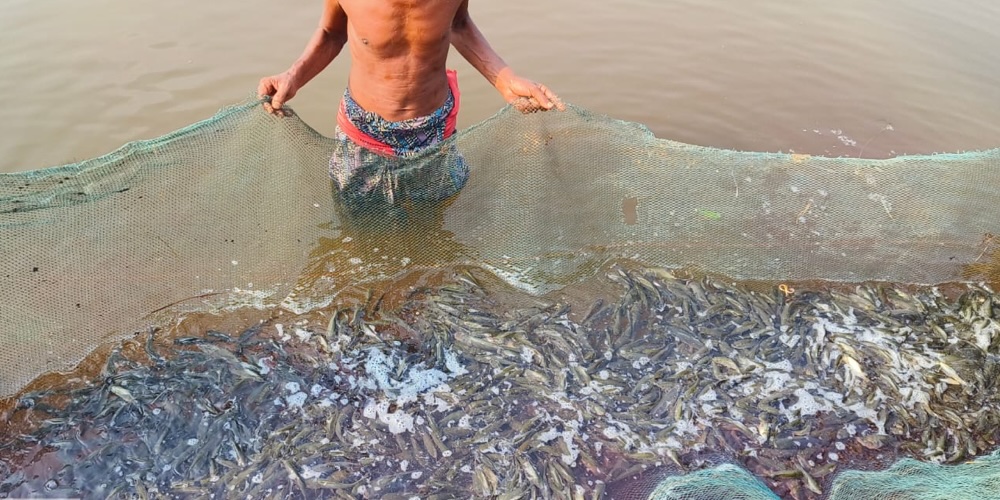
Fisheries have a major role in livelihoods, especially in developing nations like India, by providing immediate nutrition, generating revenue, and providing wider socioeconomic advantages including reducing poverty. Livelihoods centered around fishing are known for their intricacy, flexibility, and vibrancy. Fishing can be a full-time endeavor, incorporated into other livestock and agricultural systems, or used as a seasonal coping mechanism. Even while fishermen and small-scale farmers face financial difficulties, the money made from selling fish gives them vital access to resources like food security, healthcare, and education.
Fisheries are extremely vulnerable to outside stresses, such as environmental shifts brought on by climate change, even though they play a significant role in lowering economic and nutritional vulnerabilities. Therefore, policymakers must fully acknowledge the multifunctional relevance of fisheries to local economies and livelihoods in order to implement methods that ensure the long-term viability of sustainable resource management.
In this light, the Odisha Integrated Irrigation Project for Climate Resilient Agriculture (OIIPCRA) is a progressive program designed to support climate resilience in agriculture while improving rural livelihoods. By promoting fish farming operations, the aquaculture subcomponent of this project is essential in assisting communities in adapting to the effects of climate change. This blog examines the primary sources of income generated by the aquaculture subcomponent and how they support rural & marginal communities' sustainable economic development.
What Are Livelihood Assets?
Livelihood assets are the resources that individuals or households use to secure their means of living. They are typically classified into five categories:
- Natural Capital: Access to natural resources like water and land.
- Physical Capital: Infrastructure, equipment, and tools that enhance productivity.
- Human Capital: Knowledge, skills, and health that improve the capacity to work.
- Financial Capital: financial assistance, income, profit and other economic resources.
- Social Capital: Networks, relationships, and community organizations that provide support.

Through the aquaculture subcomponent of OIIPCRA, these assets are strengthened to empower rural communities, improve fish farming practices, and build long-term resilience to climate change.
1. Natural Capital: Utilizing Water Bodies for Fish Farming
Odisha is home to abundant natural water resources, including ponds, reservoirs, and rivers, which are essential for aquaculture. Under OIIPCRA, these resources are optimized for climate-resilient fish farming by:
- Execution at existing water bodies like Minor Irrigation Projects, farmer’s ponds and tanks to increase their potential for fish production.
- Encouraging the farming of climate-resilient fish species that are better suited to changing environmental conditions.
This enhancement of natural capital enables farmers to diversify their income through fish farming while conserving natural ecosystems.
Odisha boasts a wealth of natural water resources, as mentioned earlier, which are critical assets for aquaculture. Under the Odisha Integrated Irrigation Project for Climate Resilient Agriculture (OIIPCRA), these resources are being leveraged for climate-resilient fish farming through the following measures:
- Utilization of unused existing water bodies, such as village ponds and tanks, to enhance their capacity for fish production.
- Promoting the cultivation of climate-resilient fish species like Amur carp, Minor Carps, Mola, Monoculture of GIFT Tilapia and Pangasius in species diversification, poly culture, adapting new resilient aquaculture practices & technology with better management practices that are better adaptation strategy to reduce the risk and mitigate climate change impact.
- Developing freshwater prawn nurseries and Rice cum Fish farming to assist marginal farmers and community-based groups in producing high-quality prawn juveniles, promoting revenue creation, strengthening livelihoods, and improving resilience against the effects of climate change on productivity.
By optimizing these natural capital assets, farmers can diversify their income streams through sustainable aquaculture while contributing to the conservation of local ecosystems.

2. Physical Capital: Improving Aquaculture Infrastructure
The project also invests heavily in building physical capital to support efficient fish farming. This includes:
- Upgrading fish hatcheries and nurseries to provide quality fingerlings for stocking ponds and tanks year around under Early breeding Programme.
- Demonstrating Mola seed production within existing finfish hatcheries to provide seed supplies for local farmers and support groups, boosting nutrition, productivity and building resilience against climate change effects.
- Providing fish farming equipment, such as, feed mixing and pelletizer unit, to promote supplementary feeding by farmers using locally available fish feed ingredients. Water testing kit to monitor water quality parameters for adaptive measures to increase fish production in this climate changing scenario ultimately improve productivity.
- Supporting fish harvesting through the provision of drag nets and strengthening post-harvest marketing infrastructure, such as three- and four-wheel vehicles with ice boxes.
These improvements in physical capital make aquaculture more productive and sustainable, helping farmers manage water resources and reduce losses during adverse weather conditions.
3. Human Capital: Enhancing Skills and Knowledge
Human capital is vital for the success of climate-resilient aquaculture. OIIPCRA places significant emphasis on capacity building with the partnership of WorldFish by offering:
- Capacity building program for aquaculture stakeholders to enhance knowledge of aquatic food production systems and strengthen community-based frameworks. The program will provide participants with advanced technical know-how, useful perspectives, and creative methods to boost output, guarantee environmental sustainability, and raise aquaculture's general level of efficiency. Along with encouraging collaboration between regional farmers, research institutes & other groups. The objective is to ensure the aquaculture industry's long-term profitability and resilience by cultivating a knowledgeable, competent, and cooperative network of beneficiaries.
- District-level training programs under OIIPCRA cover essential components such as best management practices in fish farming. These include pond management, fish health monitoring, sustainable feed usage, water testing benefits, and the use of various aquaculture equipment, providing comprehensive technical support.
- National and international exposure visits help stakeholders with valuable insights into innovative technologies and practices adopted in other states and countries. This co-learning and knowledge-sharing experience equips them with practical knowledge to implement these technologies in their own fields, ultimately enhancing production and productivity.
- Education on climate-smart aquaculture techniques, such as Rice-cum fish integrated farming polyculture and nursery rearing of freshwater prawn, which increase yield while reducing environmental impacts.
- Workshops on financial literacy, helping fish farmers understand how to manage their resources, apply for loans, and access markets.
By improving human capital, the project equips farmers with the knowledge and skills they need to adapt to climate change and boost their incomes from aquaculture.
4. Financial Capital: Access to Funding and Markets
Access to financial resources is essential for scaling up fish farming operations. The aquaculture subcomponent facilitates:
- 100% financial assistance has given to the project beneficiaries under OIIPCRA to support them to implement this climate resilient aquaculture activities.
- Support has been provided to build market linkages, enabling farmers to sell their fish at competitive prices. Fish marketing infrastructure, including three- and four-wheeler vehicles, has been supplied to project beneficiaries to support this effort.
- Financial assistance for the creation of Pani Panchayat, Co-operatives, allowing small-scale fish farmers to pool their resources and collectively negotiate better terms with buyers.
Through improved access to financial capital, fish farmers are empowered to invest in their operations and build more resilient businesses.

5. Social Capital: Strengthening Community Collaboration
- The success of the aquaculture subcomponent also hinges on the development of strong social networks within rural communities. The project fosters social capital by:
- Supporting the self-help groups (SHGs) and fish farming cooperatives to work in different component of Aquaculture, that allow them to share resources, knowledge, and risks.
- Promoting community-based management like Pani Panchayat of water bodies, ensuring that resources are sustainably used and maintained.
- Encouraging collaboration between government agencies, NGOs, and private sector to provide ongoing support and ensure the long-term success of aquaculture ventures.
By strengthening social capital, the project builds a sense of collective responsibility and resilience, ensuring that communities work together to sustain their livelihoods.
Building Climate-Resilient Livelihoods through Aquaculture
The aquaculture subcomponent of the Odisha Integrated Irrigation Project for Climate Resilient Agriculture demonstrates how investment in livelihood assets can create sustainable income opportunities while enhancing climate resilience. By focusing on natural, physical, human, financial, and social capital, the project not only improves fish farming practices but also strengthens the overall economic stability of rural communities.
As climate change continues to threaten traditional agriculture, aquaculture offers a valuable alternative for livelihood diversification. Through the development of climate-resilient aquaculture, Odisha is setting an example for other regions on how to build sustainable and adaptable agricultural systems that benefit both people and the environment.
This comprehensive approach to livelihood development ensures that rural and marginal communities in Odisha are better equipped to face climate challenges while building prosperous and resilient futures.

